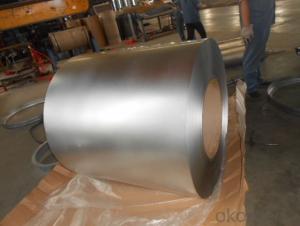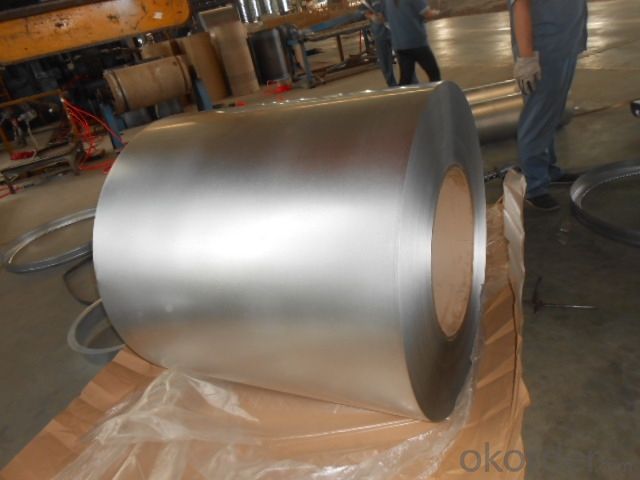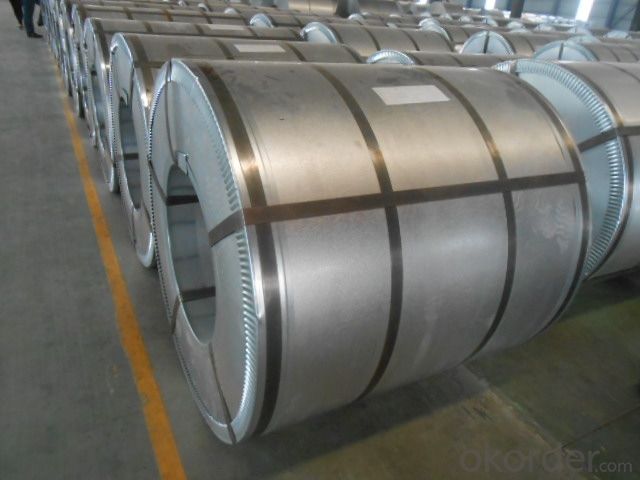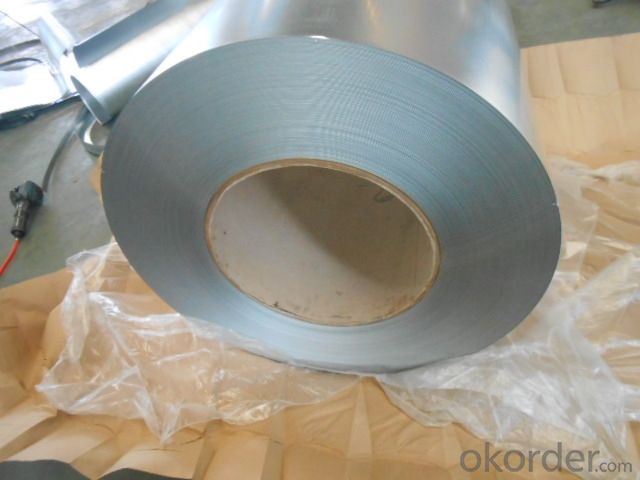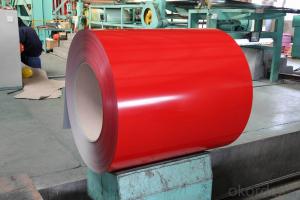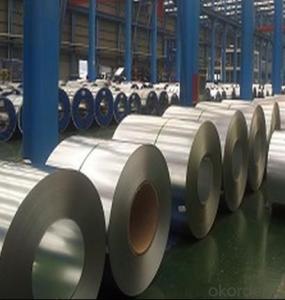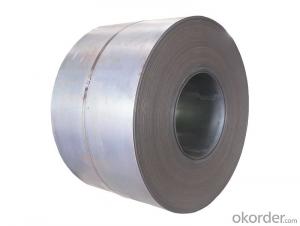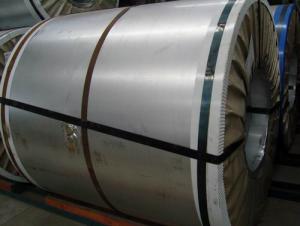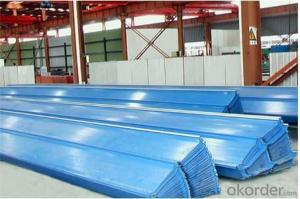Galvalume Steel Coil
- Loading Port:
- China Main Port
- Payment Terms:
- TT OR LC
- Min Order Qty:
- -
- Supply Capability:
- -
OKorder Service Pledge
OKorder Financial Service
You Might Also Like
Product Description:
(1). Quality Standard: ASTM A792 CS-B SGLCC JIS G3321
(2). Thickness: 0.3-2.5mm
(3). Width: 914-1250mm
(4)Coil ID:508mm/610mm
(5). Coil Weight: 3~15MT
(6)Aluminium zinc layer:AZ50~AZ150G/M²
(7)Surface treatment:passivation treatment,oiling,anti-fingerprint treatment
(8)Packaging:seaworthy packing
(9)Application:
Infrastructure : Roofing; External Siding; Garage; Shutter
Household Appliances :Oven; Air-Conditioning Ventilation System; Solar Water Heater; Electronics;
Automobile : Mobile Muffler; Vent Pipe; Catalysis Converter Heater Shield; Bottom Accessories;
Industrial Instrument : Electric Control Cabinet; Industrial Freezer Chest; Dispenser
- Q: What are the common methods of protecting steel coils from corrosion?
- Common methods of protecting steel coils from corrosion include applying a protective coating, such as zinc or paint, using corrosion inhibitors, storing coils in a controlled environment with low humidity, and implementing proper handling and packaging techniques to prevent moisture exposure.
- Q: I work with stainless steel a lot and I know it's rust resistant but it's definitly not STAIN resistant. You might be able to remove some stains easier from it than you can from some other surfaces but when it does stain, its hard as heck to clean it. It takes forever to scrub stains off my stainless steel pans so maybe it should just be called rustless steel?
- It is called stainless because it is much more highly resistant to rust and corrosion. It is stainless in camparison to other steels, such as carbon steel.
- Q: How are steel coils used in the production of metal roofing?
- Steel coils are used in the production of metal roofing by being fed through a series of machines that shape, cut, and coat the steel to create the final roofing product. The coils are uncoiled and flattened, then formed into the desired profile using roll forming machines. The formed sheets are then cut into specific lengths and coated with protective layers to enhance durability and corrosion resistance. These coated steel sheets are then packaged and shipped to construction sites for installation as metal roofing.
- Q: I was wondering what material most common motorcycle gas tanks are made out of? is it steel? stainless steel? aluminum? what are the advantages and disadvantages or each?
- Steel is the norm. Aluminum is lighter, but can be prone to cracking from vibration. It is seen more often in custom tanks, especially for custom cafe racers, Guzzis, Ducatis, Tritons, and the like. Dirt bikes use plastic tanks. Most after-market tanks for dual sports and adventure tourers are also made from plastic.
- Q: What are the different methods of heat treatment for steel coils?
- There are several methods of heat treatment for steel coils, including annealing, quenching, tempering, normalizing, and stress relieving. Each method involves heating the steel to a specific temperature and then cooling it in a controlled manner to achieve desired properties such as increased hardness, improved strength, or reduced residual stresses. These methods can be tailored based on the specific requirements of the steel and the intended application.
- Q: How do steel coils contribute to the energy sector?
- Steel coils contribute to the energy sector by being a crucial component in the construction and maintenance of power plants, transmission towers, and renewable energy infrastructure. These coils are used to manufacture equipment like turbines, generators, transformers, and pipelines, which are vital for the efficient generation, transmission, and distribution of electricity. Additionally, steel coils are also used in the manufacturing of energy-efficient appliances and vehicles, further promoting sustainability in the energy sector.
- Q: How are steel coils used in the production of wire products?
- Wire products rely heavily on steel coils, which are indispensable in their production. These coils, typically crafted from high-quality steel, serve as raw materials in wire drawing processes. Wire drawing, a manufacturing technique, diminishes the coil's diameter, converting it into diverse wire products. The initial step involves the placement of a steel coil onto a wire drawing machine. Subsequently, the machine pulls the coil through a sequence of progressively smaller dies. Each die the coil passes through reduces the wire's diameter, resulting in a more slender and elongated wire strand. This process can be repeated multiple times until the desired wire thickness is achieved. Once the wire is drawn, it can undergo further processing to create an array of wire products, including fencing, nails, screws, springs, and electrical wires. The wire can be cut into specific lengths, bent, or shaped to suit its intended purpose. Moreover, it can undergo treatments like galvanizing or coating to enhance its durability and resistance to corrosion. Steel coils offer numerous advantages in wire product manufacturing. Firstly, they provide a consistent and uniform material, ensuring the resulting wire products possess consistent quality and performance. Secondly, steel coils are easily transportable and can be stored efficiently, making them a cost-effective choice for manufacturers. Lastly, the versatility of steel enables the production of wire products with varying tensile strengths and properties to meet specific industry requirements. To summarize, steel coils play an essential role in wire product manufacturing. They serve as the primary raw material in wire drawing processes, where they undergo a series of reduction steps to be transformed into diverse wire products. These wire products find applications across various industries, solidifying the indispensability of steel coils in the manufacturing sector.
- Q: What are the common coil defects and their causes?
- Some common coil defects include edge wave, center buckle, oil canning, and coil breaks. These defects can occur due to various causes such as improper tension during the coiling process, uneven cooling, material defects, or inadequate lubrication.
- Q: Question about steel type used in bridges.?
- It is used for other things besides bridges and that might be a bad use. Corten was used for very tall light standards in the Fort Worth Water Gardens with the clear understanding that it was to be kept dry. As time passed and personnel changed, somebody decided the round base with bolts sticking up was ugly and put dirt and plantings in the basin in the concrete holding the poles. The watering of the plants kept the rust going through the steel and one pole eventually fell, killing two people. The other light poles were removed.
- Q: How are steel coils used in the production of metal signage?
- Steel coils are an essential component in the production of metal signage. These coils are typically made from high-quality steel and come in various thicknesses and widths. The use of steel coils allows for efficient and cost-effective manufacturing processes. To begin, steel coils are unwound and fed into a machine called a roll former or a metal press. This machine shapes the steel into the desired form and design for the signage. The coils' ability to be easily manipulated and shaped makes them ideal for creating intricate and customized signage designs. Once the steel has been formed, it can undergo various processes to enhance its appearance and durability. For instance, the steel may be coated with a layer of paint or powder coating to protect it from corrosion and provide a visually appealing finish. This coating can also be customized to match specific branding or design requirements. After the steel has been shaped and coated, it can be further processed to add features such as embossing or perforations. These additional details can enhance the overall aesthetic appeal of the metal signage and make it stand out. Furthermore, steel coils offer excellent structural integrity, ensuring that the metal signage remains strong and durable even in harsh environmental conditions. This durability is particularly crucial for outdoor signage that needs to withstand exposure to weather elements such as rain, wind, and sunlight. In summary, steel coils play a vital role in the production of metal signage. Their versatility, durability, and ease of manipulation make them an ideal material for creating customized designs. Whether it's for indoor or outdoor use, steel coils provide the necessary strength and aesthetic appeal required for high-quality metal signage.
Send your message to us
Galvalume Steel Coil
- Loading Port:
- China Main Port
- Payment Terms:
- TT OR LC
- Min Order Qty:
- -
- Supply Capability:
- -
OKorder Service Pledge
OKorder Financial Service
Similar products
Hot products
Hot Searches
Related keywords
